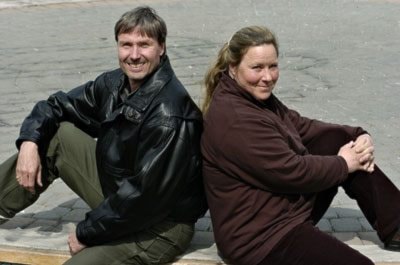The 2007 Canada Winter Games would not have gone ahead without him, and the avalanche awareness of Yukoners would be stuck in the dark if not for her.
Wearing yellow rose corsages, Don Wilson and Kirstie Simpson graciously accepted the certificates, silver lapel pins, and coloured jacket crests that marked them as top ski patrollers at a ceremony in Ottawa in early May.
“They’re pretty prestigious awards,” said Tim Sellars, the Yukon Zone president of the Canadian Ski Patrol System.
“Every year they only give them out to five or six out of 6,000 patrollers across the country,” he said.
The Canadian Ski Patrol System (CSPS) is the decades-old national organization that provides and regulates ski patroller training for nordic, alpine, and avalanche-danger environments.
The Canadian Ski Patroller Award complements a host of other types of service awards, but is distinguished as the “highest operating award” according to the CSPS.
Though partially a form of recognition, the award is also intended to motivate patrollers to create and keep up a high level of engagement with the skiing community.
Six Canadian Ski Patroller awards were issued this year; two of those flew into the hands of Yukoners.
Forty-nine year-old Don Wilson is a senior environmental scientist with EBA Engineering Consultants, Ltd. He’s been a ski patroller since the early ‘80s.
When Mount Sima opened in 1993, Wilson was one of only three qualified patrollers with alpine experience.
Wilson had to lead a team in building backboards and splints to supply the ski hill’s patrol stations.
They also had to train 40 more patrollers that year.
In addition to regular volunteer patrolling and training these past three years, Wilson’s major contribution to the region was negotiating safety logistics for the biggest sporting event the North had yet seen.
“My job for the Games was to make sure we had enough equipment and patrollers to adequately cover all the different races and the practices that were going on at any one particular time,” he said.
Thirty qualified Yukoners were available to take up stations along the slalom courses and cross-country trails, and 10 patrollers were borrowed from Outside.
The ski competitions could not have gone forward without a sufficient force of on-hand, first-aid trained ski patrollers.
Still, even though regulations and liability made the patroller presence necessary, circumstance thankfully did not.
“We were quite happy with the fact that there were not a lot of injuries,” said Wilson.
Ex-biathlete and ex-cross country ski racer Kirstie Simpson has volunteered for the ski patrol for the past 15 years.
She is also a pioneer in avalanche study, preparedness and outreach in the Yukon.
“We (the Whitehorse area) have what’s called avalanche terrain,” said Simpson.
Haines and White passes pose obvious avalanche risks to winter adventurers, but even Whitehorse’s clay cliffs, Rabbit Foot’s Canyon, the quarry hills around the subdivisions and Mount Sima hold the potential for catastrophe in precipitous weather.
“It’s a question of whether or not the snow on top of that terrain equals avalanche danger,” said Simpson.
Simpson is the only fully certified avalanche instructor in the Yukon, according to Sellars.
Simpson has collaborated with the Yukon Education department to assess avalanche risks in key winter field trip locations. The 40-something blonde is also recognizable as the handler for Jake, an avalanche search and rescue dog who can ride Mount Sima’s chairlifts with a special suspended harness.
Simpson keeps her knowledge current by networking with avalanche experts in BC and Alberta when not at her day job with the ministry of Energy, Mines, And Resources in Whitehorse.
The cross-country aficionado also volunteers regularly — perhaps too regularly — with Mount Sima’s alpine patrol.
“It’s always a difficulty to balance the two. We have regular shifts we have to do to cover the ski hill, which sometimes interfere with some of the big nordic races,” she said.
Most ski patrollers registered with the Canadian Ski Patrol work on a volunteer basis, though some are paid to cover unpopular weekday shifts over the season.
It’s a lot of work, keeping the slopes and trails open. It takes commitment, time, and energy, but the benefits go far beyond winning top-medals, according to Sellars: “Community service, the camaraderie, getting the opportunity to ski with friends, and, well, there’s free skiing.”
